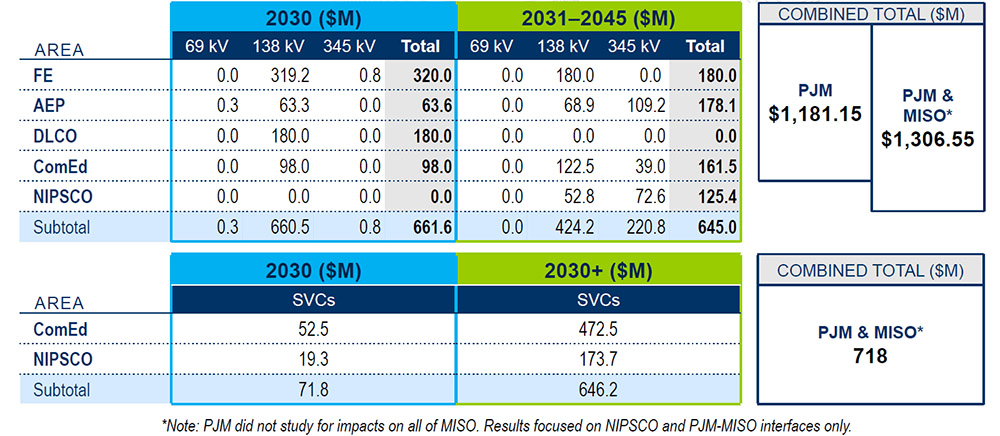Issue Charge Approved on Day-ahead Zonal Load Bus Distribution Factors
VALLEY FORGE, Pa. — The PJM Market Implementation Committee last week approved an issue charge to consider a new method of determining day-ahead zonal load bus distribution factors.
The RTO’s current rules state that the default distribution of load buses for a zone in the day-ahead energy market is the state-estimated distribution of load for that zone at 8 a.m. one week prior to the operating day. Thus, the share of the zonal load attributed to each node remains constant for all 24 hours, even though the node’s share of total load may vary throughout the day because of nonconforming loads, such as data centers and behind-the-meter solar. This can cause a mismatch between the day-ahead nodal loads and real-time state-estimated load, according to the problem/opportunity statement.
Amanda Martin, who presented the issue at the committee’s meeting Wednesday, said the mismatch is not currently a concern but that PJM expects it to become one with the growth in nonconforming loads.
 Jason Barker, Constellation Energy | © RTO Insider LLC
Jason Barker, Constellation Energy | © RTO Insider LLCThe committee unanimously approved the issue charge under the “CBIR Lite” (Consensus Based Issue Resolution) process despite the concerns of some stakeholders that the issue is more complicated than portrayed: Martin said it affects a single line in the tariff.
Paul Sotkiewicz of E-Cubed Policy Associates said the issue is not appropriate for CBIR Lite.
“I can think of places in PJM where just a small change [in distribution factors] can change plant commitments. This is not a trivial issue,” he said. “It can change pricing. It can change commitments in real time. I don’t think we can come up with a solution without doing that hard work [to model the impacts of the change]. Otherwise we’re just guessing.”
Independent Market Monitor Joe Bowring said he supported PJM’s proposal but that it should also create an initiative to consider long-term implications.
“Using one hour at 8 a.m. for all 24 hours makes no sense. To me this is clearly and obviously an improvement,” he said.
“If it needs more analysis, fine,” Constellation Energy’s Jason Barker said. “I don’t think we need to make a science experiment out of it.”
To address stakeholders’ concerns, PJM added to the issue charge a requirement that the initiative include an historical analysis to evaluate the impact of proposed solutions relative to the current practice.
The work is expected to take four months, with changes to tariff section 31.7c(i) and updates to Manual 11 and Manual 28.
Variable Operations & Maintenance Cost Development
Members heard a first read on competing proposals by PJM and Constellation Energy on changes to variable operations and maintenance (VOM) cost development that differ over the treatment of nuclear refueling costs and associated major maintenance.
The PJM proposal includes default adders for minor maintenance and operating costs; a new review process and timeline; clarifications to definitions of major and minor maintenance; and clarifications to requirements on supporting documentation.
Barker said that Constellation, the largest nuclear operator in the U.S., treats the projects undertaken during planned refuelings as fixed costs because they are scheduled long in advance, irrespective of the number of starts. As a result, he said, they should be included in capacity offers rather than as VOM in energy offers.
Barker said Constellation generally agrees with PJM’s desire to move most variable costs into cost-based offers. But he said the RTO incorrectly classifies projects associated with planned nuclear outages as major maintenance costs, defined as costs that “vary directly with electric production.”
Nuclear units would not likely have an opportunity to recover costs through a cost-based offer because they are price takers that bid zero into the energy market and are highly unlikely to be dispatched on a cost-based energy offer.
“PJM’s definitions don’t apply well to the nuclear fleet,” he said.
“You’re suggesting a significant change to the definition of what can go into VOM versus what’s allowable in the capacity market,” Bowring said. “This is way beyond the scope of the proposal by PJM. This is about how the review process is conducted, not the definitions of what is VOM.”
Barker insisted he was not seeking a “major change.”
“What we’re trying to do is accurately reflect the nature of nuclear cost accounting,” he said.
MIC Chair Lisa Morelli said she was “not prepared to rule on [the procedural question] now.”
PJM’s Tom Hauske said the RTO considers any cost based on starts and run times as variable and does not distinguish between capital and operating expenses.
PJM’s Glen Boyle said the RTO “wanted the stakeholder process to play out and see where the stakeholders were” on the question.
Heather Svenson of Public Service Enterprise Group said her company “strongly supports” Constellation’s proposal. It is “not a carve out” for nuclear units, she insisted.
The committee will be asked to vote on the proposals at its next meeting.
Manual Revisions OK’d on Reserve Price Formation
Members endorsed revisions to Manual 15: Cost Development Guidelines to conform with FERC’s order approving revised energy price formation rules (EL19-58, ER19-1486).
It will be effective Oct. 1, contingent on FERC approval of PJM’s compliance filing in EL19-58-012.
The changes remove VOM from synchronized reserve offers and eliminate references to Tier 1 and Tier 2 offers to reflect the consolidation of the tiers.



